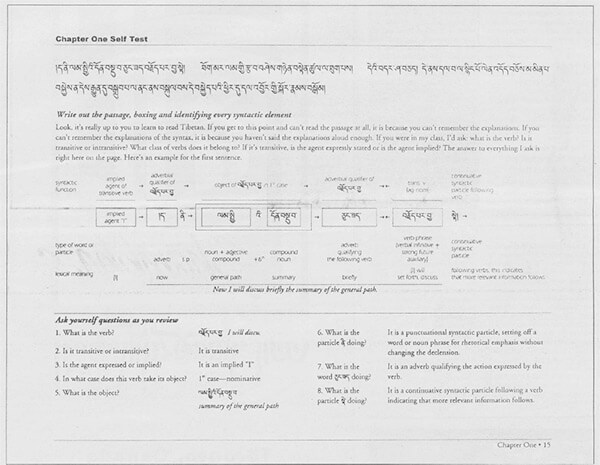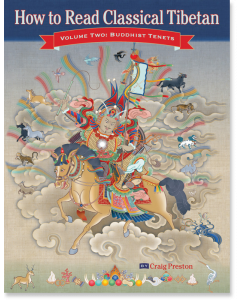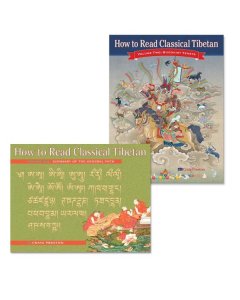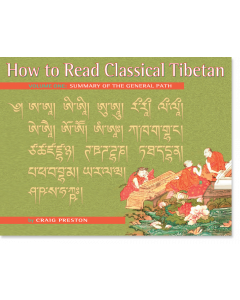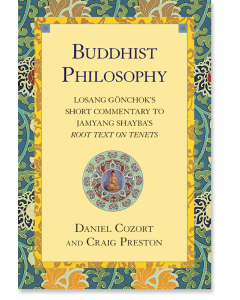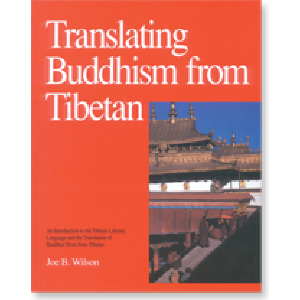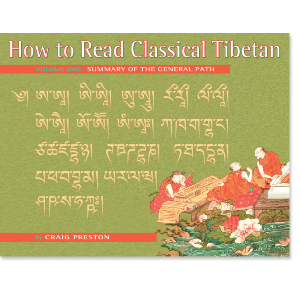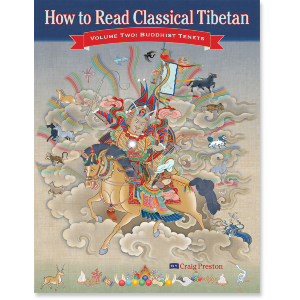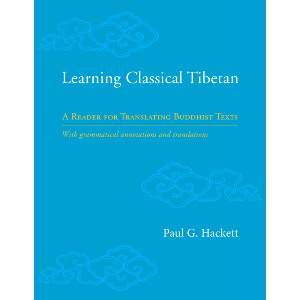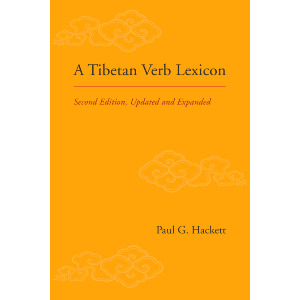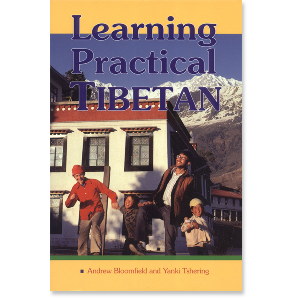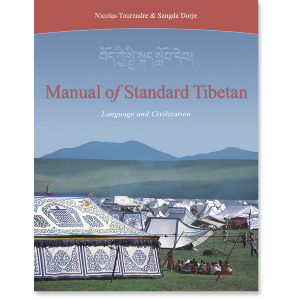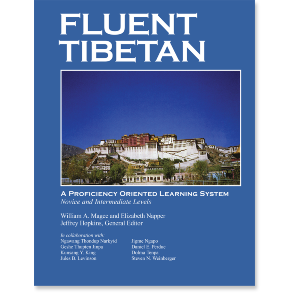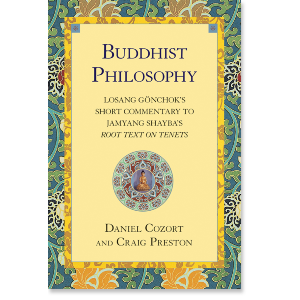Interested in learning Tibetan or deepening your existing Tibetan language skills? Below is a guide to help you choose the right resources for your needs. We offer two tracks: one for those who plan on traveling or spending a longer period of time in India, Nepal, Bhutan, China, and Tibet; and another for those who are focused on classical written Tibetan for academic or practice purposes.
Craig Preston
Craig Preston studied at the University of Virginia and has taught Classical Tibetan at the Namgyal Institute and the University of Buffalo. He is the author of How to Read Classical Tibetan, Volume 1: A Summary of the General Path, and currently teaches Tibetan and Buddhist philosophy privately in Ithaca, New York.
Craig Preston
GUIDES
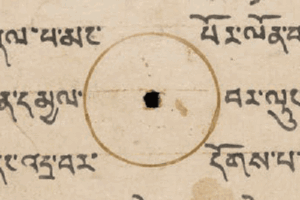
Tibetan Language Reader's Guide

Reading or Translating Classical Tibetan
The following materials are geared for those wanting in-depth study of the written language of Tibet, including the classical and literary. These were all designed to work together and complement each other, though can be used stand-alone as well. For spoken/colloquial Tibetan, skip to that section below.
Translating Buddhism from Tibetan
This book is the foundation for the books that follow. It's a complete textbook on classical Tibetan suitable for beginning or intermediate students. Based on the system developed by Jeffrey Hopkins at the University of Virginia, it presents—in lessons with drills and reading exercises—a practical introduction to Tibetan grammar, syntax, and technical vocabulary used in Buddhist works on philosophy and meditation. A well-designed learning system, it serves as an introduction to reading and translating Tibetan as well as to Buddhist philosophy and meditation. Each chapter contains a vocabulary of helpful Buddhist terms. Students with prior experience will find that the seven appendices—which review the rules of pronunciation, grammar, and syntax—are an indispensable reference.
How to Read Classical Tibetan, Volume One
Craig Preston, the author, recommends that people study Translating Buddhism from Tibetan as a preliminary to using this book. This is a complete language course built around the exposition of a famous Tibetan text, Summary of the General Path to Buddhahood, written at the beginning of the fifteenth century. All the language tools you need to work at your own pace are here in one place. You won't need a dictionary because all the words and particles are translated and explained in each occurrence, and there is a complete glossary at the end of the book. Every sentence is diagrammed and completely explained so that you can easily see how the words and particles are arranged to convey meaning. Because everything is explained in every sentence, you will learn to recognize the recurrent patterns, which makes the transition from learning words to reading sentences easier than it would be otherwise. As you study How to Read Classical Tibetan, you will learn to recognize the syntactic relationships you encounter, understand the meaning signified, and translate that meaning correctly into English.
How to Read Classical Tibetan, Volume Two
A follow-up to Volume One, this book assumes the reader is familiar with both the previous volume and Translating Buddhism from Tibetan.
Learning Classical Tibetan: A Reader for Translating Buddhist Texts
Designed for both classroom use and independent study, Learning Classical Tibetan is a modern and accessible reader for studying traditional Buddhist texts. Unlike other readers of Classical Tibetan, this is a comprehensive manual for navigating Tibetan Buddhist literature drawing on a monastic curriculum. Utilizing the most up-to-date teaching methods and tools for Tibetan language training, students learn to navigate the grammar, vocabulary, syntax, and style of Classical Tibetan while also engaging the content of Buddhist philosophical works.
Chapters consist of a contextual introduction to each reading, a Tibetan text marked with references to annotations that provide progressive explanations of grammar, cultural notes on vocabulary, translation hints, notes on the Sanskrit origins of Tibetan expressions and grammatical structures, as well as a literal translation of the text. The reader also includes study plans for classroom use, discussion of dictionaries and other helpful resources, a glossary of English grammatical and linguistic terms, and much more.
This reader can be used in conjunction with Paul Hackett’s expanded edition of his well-known Tibetan Verb Lexicon. Using a clear and approachable style, Hackett provides a practical and complete manual that will surely benefit all students of Classical Tibetan.
A Tibetan Verb Lexicon
This is the second and much-expanded edition of this essential resource for those studying or translating Tibetan. edition . With over 4,500 entries of the most frequently used Tibetan verbs, this new edition of Hackett’s highly acclaimed Tibetan Verb Lexicon is an incomparable lexical resource. This comprehensive verb dictionary includes various verb forms, verbal collocations, auxiliary constructions together with grammatical information, Sanskrit equivalents, and example sentences, making it a vital tool for any translator, writer, or scholar who intends to maximize the quality of their work related to the Tibetan language.
Much more than a mere translation of existing works, this lexicon was compiled employing statistical techniques and data and draws on sources spanning the 1,200 years of Tibet's classical literature, covering all major lineages. The 4,500 root verb forms and phrasal verb subentries incorporates a wide range of information not previously available in dictionary form. The individual entries are in Tibetan script and contain English meanings, Sanskrit equivalents, complete sentences drawn from the corpus of Tibetan classical literature, and related sentence structure information. An extensive introduction to contemporary linguistic theory as applied to Tibetan verbs provides the theoretical underpinnings of the lexicon. Paul Hackett, the author, strongly encourages readers to become familiar with Translating Buddhism from Tibetan before approaching this book.
Spoken and Written Modern Tibetan
Below you will see our resources if you with to speak and read modern, colloquial Tibetan.
Learning Practical Tibetan
This book, for the casual traveler and aspiring student, offers a great overview, packed with practical examples for the casual student. It gives the basics of grammar and phonetics and offers practical sample dialogues. And it is small enough that you could easily take it with you on your adventure! It starts off with some basic grammar and vocabulary and then moves into dialogues for eating, shopping, visiting monasteries, transportation, and more.
Manual of Standard Tibetan
In this comprehensive treatment of modern Tibetan, you'll learn about the everyday speech of Lhasa as it is currently used in Tibet and in the Tibetan diaspora. It not only places the language in its natural context but also highlights key aspects of Tibetan civilization and Vajrayana Buddhism. The manual, which consists of forty-one lessons, includes many drawings and photographs as well as two political and linguistic maps of Tibet. You'll find the appendices especially helpful as they outline the differences between written literary and spoken Tibetan; detail pronunciation; and explain the use of honorific words, compound terms, and transfers from other languages. Two CDs provide an essential aural complement to the manual, making it a very practical guide for more serious students.
Fluent Tibetan
This book is a fully comprehensive course in spoken Tibetan which has MP3 files to support a real immersion experience. The most systematic and extensive course system now available for spoken Tibetan, Fluent Tibetan was developed by language experts working in conjunction with indigenous speakers at the University of Virginia. Based on government-approved courses for diplomats needing to learn a language quickly, the method acquaints students with the sounds and patterns of Tibetan speech through repetitive interactive drills, enabling the quick mastery of increasingly complex structures and thereby promoting rapid progress in speaking the language.
$150.00 - Hardcover
SNOW LION NEWSLETTER ARCHIVE
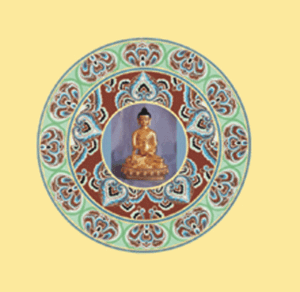
| The following article is from the Autumn, 2003 issue of the Snow Lion Newsletter and is for historical reference only. You can see this in context of the original newsletter here. |
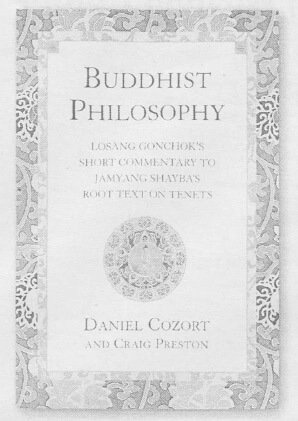
What are the most important points of difference between the major schools of Buddhist philosophy? This rich, medium-length survey offers a lively answer. The introduction, aimed at those new to Buddhist thought, sets up a dialogue between the schools on the most controversial topics in Buddhist philosophy.
Jamyang Shayba was the greatest Tibetan writer on philosophical tenets. Losang Gonchok's Clear Crystal Mirror, a concise commentary on Jamyang Shayba's root text, represents a distillation of many centuries of Indian and Tibetan scholarship. Buddhist Philosophy skims the cream of Jamyang Shayba's intellect, providing a rare opportunity to sharpen our intellect and expand our view of Buddhist thought. Daniel Cozort is associate professor and chair of the Department of Religion at Dickinson College where he teaches the religions of India. He is the author of Highest Yoga Tantra. Craig Preston studied at the University of Virginia and has taught Classical Tibetan at Namgyal Institute. He is author of How to Read Classical Tibetan, Vol. 1: A Summary of the General Path and currently teaches Tibetan and Buddhist philosophy privately in Ithaca, New York.
The following is an excerpt from Buddhist Philosophy.
Nirvana With and Without Remainder
Nirvana is neither a place nor a mental state. It is a fact about us. A nirvana is the absence of afflictions in someone whose cultivation of wisdom has resulted in the destruction of ignorance, desire, hatred, etc. That mere absence is the nirvana.
On that, all Buddhist schools agree. However, they disagree over the use of the term remainder used in conjunction with nirvana. Other than Prasangika, it is said that after a person attains nirvana, he or she subsequently can be said to have a nirvana with remainder, the remainder being the body and mind. Death cuts the remainder. However, the nirvana without remainder is a single moment, occurring just at the time of death but not after. After death there is no person to whom the nirvana can belong!
Hinayana schools do not recognize any existence after death for an Arhat. The Mahayana schools do, and all except Asanga's say that Arhats manifest in different forms, no longer helplessly reborn according to karma, and continue to cultivate wisdom and merit until they have become Buddhas. Because Asanga and his followers say that there are Arhats who do not go on to Buddhahood, they must explain that those Arhats are born in the pure lands of Buddhas and abide there forever in meditative absorption.
The Prasangika school uses the term remainder in a completely different manner. For them, remainder has to do with whether or not to an Arhat things still appear to have true existence. To explain this, we have to recall what was said previously about the obstructions to liberation and obstructions to omniscience. What prevents our liberation is our conceptions of inherent existence. Things appear to us as though they exist from their own side, independently, and we assent to this appearance by conceiving of them in this way. Meditation that analyzes the way things exist will destroy this false conception, and we can be liberated from it and from the samsara it causes.

...when does a nirvana without remainder occur? It occurs only when that person is meditating on emptiness because at that time only emptiness appears to the mind.
However, because of the way we have been conditioned, which in Buddhism is a process without beginning, things still appear to exist inherently. The liberated person is someone who no longer assents to this appearance, who is always doubtful of the evidence of the senses and resists conceiving of them in the wrong way. He or she is like someone who wears sunglasses, well aware that the green tint pervading all visible objects is just the effect of the lenses. It takes a very long time for the appearance of inherent existence itself to fade. Those taints of appearances are the obstructions to omniscience.
From this perspective, then, an Arhat experiences a nirvana with remainder most of the time, since most of the time things appear falsely. But then, when does a nirvana without remainder occur? It occurs only when that person is meditating on emptiness because at that time only emptiness appears to the mind. For nonBuddhas, it is impossible for both emptiness and other tilings to appear to the mind simultaneously. (Another way of putting this is to say that the two truths cannot appear simultaneously to a non-Buddha's mind.)
So, both Prasangikas and others could identify an Arhat's usual state, the time when he or she is not absorbed in meditation on emptiness, as a nirvana with remainder, but they would mean very different things by it. Prasangikas would mean that things falsely appear to the mind; others would mean that the Arhat is alive. Similarly, both Prasangikas and others would identify the nirvana of an Arhat at the time of death as being a nirvana without remainder but they would mean something different by it. Prasangikas would mean that at that time there is no false appearance to the mind (because, for a short time, only a vacuity appears to the mind), whereas others would mean that the body and mind are abandoned.
Other than the purpose of again pressing home their contention about the empty nature of things, why do Prasanigikas change this terminology? Jamyang Shayba here gives two arguments. First, it makes no sense to say that there is any person who experiences a nirvana without remainder if that means that the aggregates are abandoned. There is no person once the aggregates are destroyed. Second, the language that suggests that Arhats "extinguish" their aggregates really just refers to their emptiness. Like all things, our bodies and minds are "primordially extinguished" into emptiness because they are, and always have been, empty of inherent existence.
| The following article is from the Autumn, 2003 issue of the Snow Lion Newsletter and is for historical reference only. You can see this in context of the original newsletter here. |
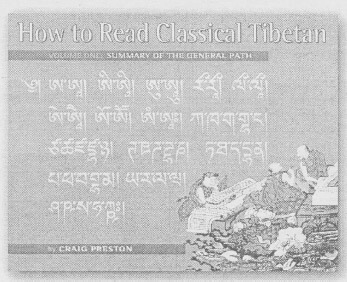
Do you want to learn to read Classical Tibetan? If you know how to read the Tibetan u-chen script and can recognize words, How to Read Classical Tibetan will show you—at your own pace—all the relationships that make Tibetan easy to read. It is a complete language course built around the exposition of a famous fifteenth century Tibetan text summarizing stages of the path to Buddhahood.
All the language tools you need to work at your own pace are in one place. You won't need a dictionary because all of the words and particles are translated and explained upon every occurrence, and there is a complete glossary at the end of the book; every sentence is diagramed and completely explained so that you can easily see how tire words and particles are arranged to convey meaning.
Because everything is always explained in every sentence, you will easily learn to recognize the recurrent patterns, making the transition from learning words to reading sentences much easier for you. As you study How to Read Classical Tibetan, you will learn to: recognize the syntactic relationships you encounter, understand the meaning signified, and translate that meaning correctly into English.
CRAIG PRESTON has been studying Tibetan Buddhism for twenty-five years. He teaches Tibetan and Buddhist philosophy in Ithaca, New York at the Nagarjuna Language Institute (www.giganticom.com) which he founded. He has taught Classical Tibetan at Dharma Farm in Charlottesville, Virginia, and in Taos, New Mexico.
Below is a sample page from How to Read Classical Tibetan, Volume 1.
